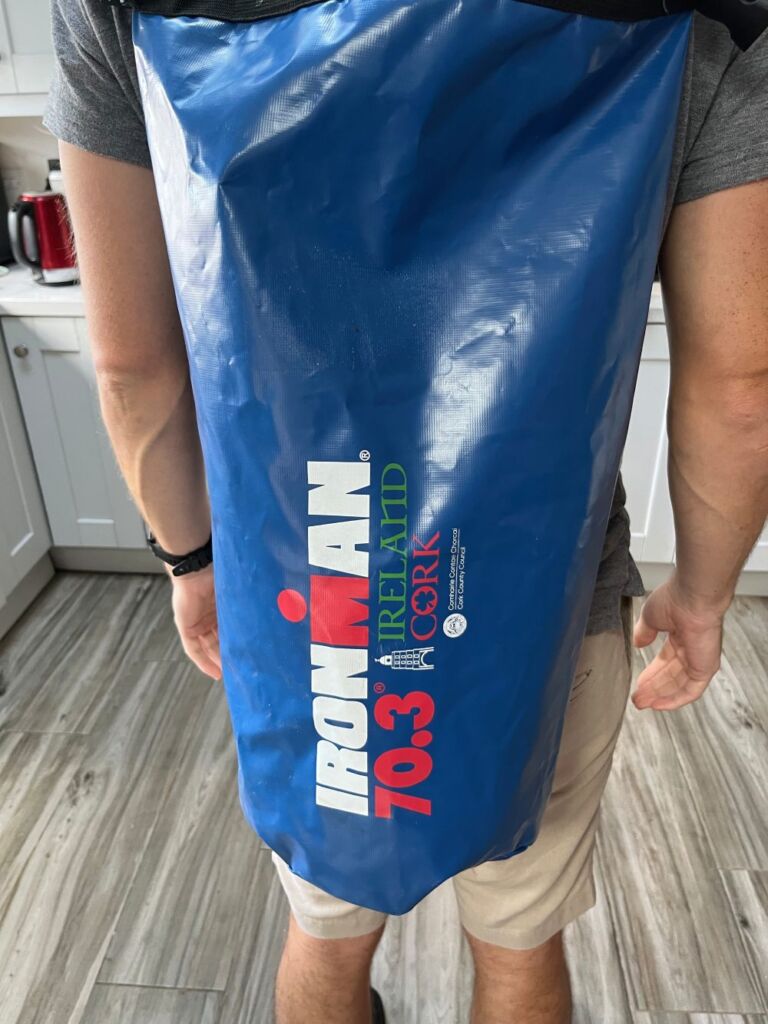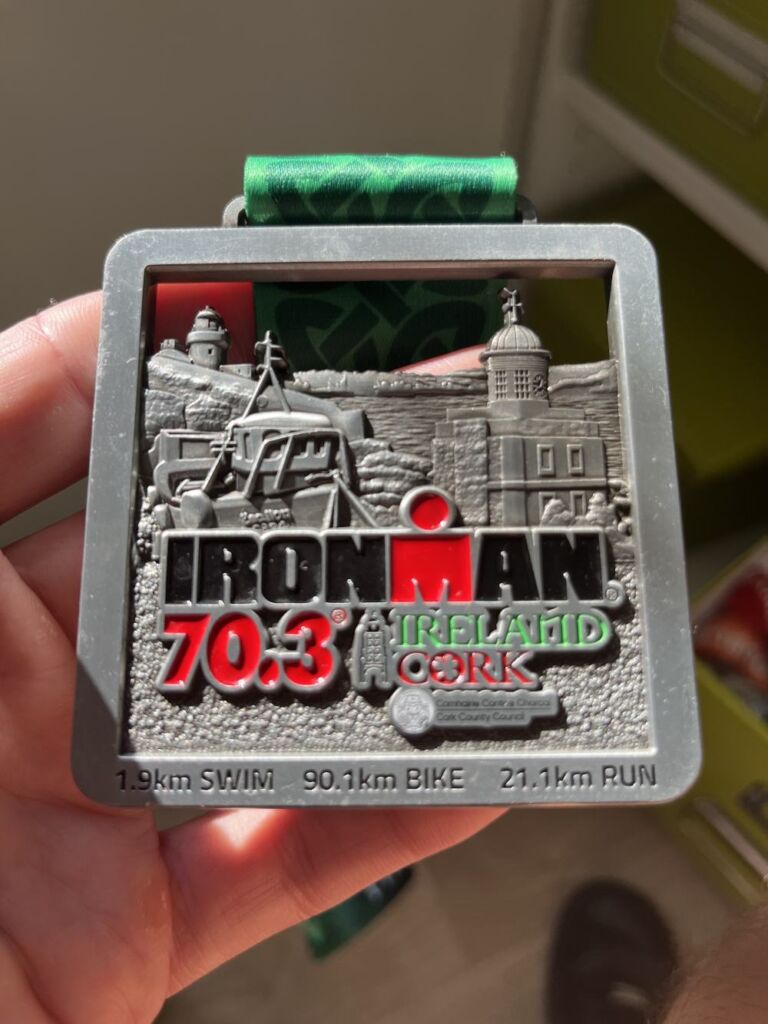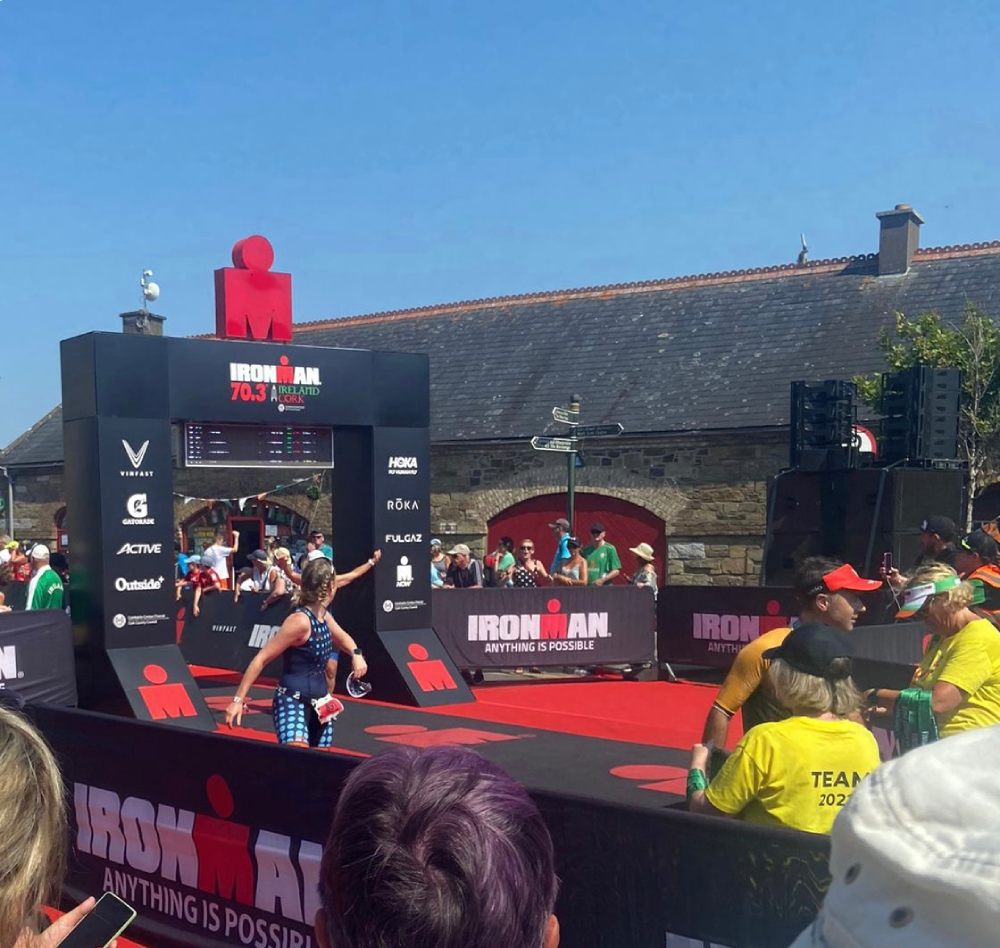Discover what to expect on your first 70.3 triathlon race or Ironman.
I completed my first 70.3 triathlon in 2022. It took about six months to train for the race. Although I’d completed several marathons before I was newer to the other disciplines, specifically open-water swimming and cycling long distances. I learnt lots about competing in a 70.3 for the first time.
If you’re considering signing up, do so! It’s more than manageable. If you’re considering signing up for a 70.3 or training for the first time, here’s what you can expect from the race.
Contents
- 1 1. Nerves
- 2 2. Expenses
- 3 3. Transport Issues
- 4 4. Niggles During The Taper
- 5 5. Lack of Sleep
- 6 6. A Crowded Start
- 7 7. Adrenaline
- 8 8. Pain and Discomfort
- 9 9. A Low Midpoint
- 10 10. Fueling and Hydration
- 11 11. Heavy Legs
- 12 12. Support From the Crowds
- 13 13. A Sense of Achievement
- 14 FAQs About What to Expect During Your First 70.3 Triathlon
1. Nerves
Completing a 70.3 Ironman or triathlon is no small feat. After all, the average finish time ranges between six and eight hours. To get there, you’ve probably spent months training all three disciplines: swimming, running, and cycling.
After putting so much work in, it’s natural to worry. Have I trained enough? Did I get my taper right? What if I forget some equipment? Will I miss the race cut-offs?
My coach said pre-race nerves and jitters are a sign you care about the race and are perfectly natural. Instead, trust your training to get you from the start to the finish line.
2. Expenses

Completing a triathlon during year one requires purchasing and acquiring lots of different equipment. As race day draws, near you may identify additional equipment to buy.
For example, if the weather is poor, perhaps you need to invest in a set of bike boot covers. If it’s warm, you’ll need to buy anti-glare Goggles and suncream. Chances are, you’ll also need to stock up on high-energy foods and drinks and electrolyte drinks. I also had to buy extra drink bottles, gels and electrolytes. Best allow for all this, several days before the race and not the day beforehand.
3. Transport Issues
A triathlon involves transporting a lot of equipment. After all, you need to pack for three different disciplines and also bring a bike. Depending on where the triathlon is based, you may be able to transport this equipment by car.
If not, spend time considering logistical issues and how you’re going to get your bike from your home to where the race is based and back again.
For help, check out our list of what to bring to a 70.3
4. Niggles During The Taper
As with training for a marathon, training for a triathlon involves tapering or reducing your training workload and volume during the two to three weeks preceding the race.
This taper gives your body time to acclimatise to the training, rest and recover. So, if you feel niggles and weird pains that’s a good sign. It means your body is getting ready to race. It’s not necessarily a sign you’re about to encounter a race-stopping injury!
5. Lack of Sleep
A 70.3 triathlon usually takes place at or after dawn so that swimmers have enough time to complete all three disciplines. We had to get up at three am to reach the race on time, check-in and start the swim at 6 am before the tide.
Don’t expect to guess the full eight hours of sleep the night before a race particularly if you’re nervous. My coach said it’s far more important to get a good night’s sleep two days before the race.
6. A Crowded Start
Depending on the size of the triathlon, athletes may start the swim together or in staggered groups. If you start in the first group or in the middle of the pack, expect to find the water crowded. You may even get bashed by other swimmers.
If the prospect of a bump or knock during a swim is off-putting, consider starting towards the rear or slowing down for the first few hundred meters until the pack opens up. You won’t lose too much time in the context of the overall race.
7. Adrenaline
The hour or so before the race is electric. Assuming it is a popular 70.3 race, you’re probably lining up with hundreds of other athletes. In some cases, their nerves may affect you.
Either way, it’s natural to feel the adrenaline surging through your veins prior to a race. Remember not to go out too fast as this is a long race rather than a sprint to the finish.
8. Pain and Discomfort
Swimming for approximately an hour, cycling for five or six hours and running for two hours is a long-distance event. And like any long-distance endurance event, expect some pain. So become comfortable with discomfort.
A triathlon of this land doesn’t necessarily mean pushing your heart rate into Zone 5 of your Garmin, but you may need to accept feeling uncomfortable on the bike after an hour or two and tired before the run. My coach said, “If it were easy, everyone would do it!”
For advice, check out our guide to mental tips for running a marathon.
9. A Low Midpoint
After the first few hundred metres of a swim, the first 10 or 15 miles of the cycle and the first few miles of the run, it’s natural to hit a midpoint for the discipline in question. You may find yourself tiring and questioning if you have got what it takes to get to the finish line.
This is where you can draw on your inner mental resources, repeat a mantra or perhaps consume some energy gels and electrolytes to keep going. In the case of the swim, I simply told myself the burning sensation in my arms was simply my body warming up and it passed after a few minutes. Remember, you trained for this! Adrenaline will kick in again as you draw towards the transition areas for each discipline.
10. Fueling and Hydration
Competing in a triathlon of this distance involves managing how often you consume energy gels or carbohydrate-rich foods as well as electrolytes.
Usually, you’ll want to consume one of these gels every 30 minutes with a sip of an electrolyte-rich drink. However, rather than worrying about this during a race, it’s best to practice your fuelling and hydration strategy during training so that you already know when to eat and drink.
Read our Maurten Gels review
11. Heavy Legs
It’s natural to complete the run section of a triathlon 10 to 20% slower than a normal half marathon where you didn’t just cycle 90KM or swim nearly 2KM.
So, expect your legs to feel heavy and like lead after you get off the bike. After running a few kilometres or for ten minutes, you will ease into the run and figure out how to keep going. It’ll help a lot if you practice these brick sessions, that is a run off a bike, in training.
12. Support From the Crowds
During training, it’s difficult to cycle three or four hours by yourself and even with a small group, at least at first. Similarly, some triathletes dislike running and find it difficult to go for more than an hour without getting bored or listening to music.
However, you shouldn’t expect this problem during a big triathlon. Locals, friends and family of athletes turn out in force to cheer on those competing. This support will provide you with an extra burst of energy and motivation to keep going even when you feel tired and are struggling.
13. A Sense of Achievement

Up to 80% of triathletes start and go on to finish a 703. So, if you are trained and prepared, the odds are in your favor. When you’ve crossed the finish line, you will feel a tremendous sense of achievement.
Enjoy getting a medal and then get some extra fluids and food into your system so that you can recover. It’s also a good idea to walk around a bit instead of sitting until your heart rate returns to normal. Then, take a moment to reflect on your training and hard work. Congratulate yourself for a race well done.
FAQs About What to Expect During Your First 70.3 Triathlon
What do you do first in a triathlon?
A triathlon typically follows this order: swim, run, cycle. For example, a 70.3 triathlon involves a 1.2-mile swim, a 56-mile bike ride, and a 13.1-mile run.
Why is swimming first in a triathlon?
Swimming is first in a triathlon as this event is usually affected by the tide and weather conditions. It’s also first as race organisers typically don’t want exhausted athletes attempting a long swim after a challenging run. A swimmer is far more likely to cramp if they exercised in another discipline beforehand. The exception is a reverse triathlon, whereby the race poses these challenges upfront to competitors.



